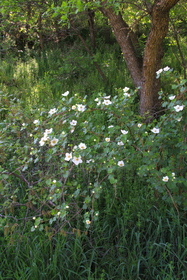


Denver Botanic Gardens Gardens Navigator Plants Collected and Described to Science from the Foothills of the Front Range on the Long Expedition of 1820 |
All Tours


|

Two-hundred years ago, during the spring of 1820, 22 men of the Stephen H. Long Expedition headed west from Engineer Cantonment, which is just north of present-day Omaha, Nebraska. They were bound for the high plains and the Front Range of present-day Colorado. Their goals were ambitious and included exploring and documenting some of the vast land acquired via the Louisiana Purchase of 1803. The group also included scientists trained in the European tradition, and their goal was to study the natural history of the area. One of these scientists was Edwin James, who doubled as the expedition’s physician and botanist.
From June 27 through July 27, the Long Expedition traveled through present-day Colorado, crossing lands ancestrally belonging to the Cheyenne, Arapaho, Eastern Shoshone, Ute, Pawnee, Jicarilla Apache, Pueblo, Comanche, Kiowa, Osage, and Pawnee tribes. Entering near Julesburg, the men followed the South Platte River southwest through the plains. Until their first view of the Rocky Mountains and what would eventually be known as Longs Peak on June 30, there were few notable landmarks other than the occasional bluff, various creeks and islands in the channels of the river. On July 6, after their 10-day journey through the hot and dry plains of Colorado, the expedition reached the foothills of the southern Rocky Mountains. Here, the group encountered many iconic landmarks including Waterton Canyon, the hogbacks near Roxborough State Park, Elephant Rock, Dawson Butte, and a view of Pikes Peak. This portion of the trip was important botanically, as some of our most common foothills natives were collected and subsequently described to science. During the week spent in this area, James and several others entered the chasm of the Platte (present-day Waterton Canyon) and bushwhacked to Sheep Mountain. (For reference, the southern terminus of the first segment of the Colorado Trail parallels the eastern side of Sheep Mountain, which is across the river.) At this location, James collected several species that would be described to science by himself, John Torrey, Asa Gray, or George Bentham. A week later, on July 14, 1820, Edwin James and two other men summited Pikes Peak, thus becoming the first Americans of European descent to have done so. This was both literally and metaphorically the high point of the Long Expedition of 1820. The group continued south, and near present-day Pueblo Reservoir, the party connected to the Arkansas River. After several members of the party took an arduous excursion to the Royal Gorge, the expedition was on its way again. The men followed the Arkansas River into southeastern Colorado, where they descended into the Purgatoire, Chacuaco and Bachicha Canyons. After a grueling journey through the canyon bottoms the party ascended to the high plains and soon reached the Colorado and New Mexico border. On September 13 the party arrived at Fort Smith, Arkansas, having completed the expedition. James carried with him around 700 plant specimens, well over 100 of which were previously unknown to science (Goodman and Lawson, 244). Many of these were collected in what would become Colorado. This tour is one of three and focuses on plant species that were collected (or were likely collected) in the foothills of Colorado’s Front Range and that were scientifically recorded on the 1820 expedition. Sources Ackerfield, Jennifer. Flora of Colorado. (Fort Worth: BRIT Press, 2017). Goodman, G. J., & Lawson, C. A. (1995). Retracing Major Stephen H. Long's 1820 expedition: the itinerary and botany. University of Oklahoma Press. William, Roger L. (2003). A Region of Astonishing Beauty: The Botanical Exploration of the Rocky Mountains. Roberts Rinehart Publishers. | |
| Map Help |

© Denver Botanic Gardens, 1007 York Street, Denver, CO 80206
Photography © Denver Botanic Gardens

Powered by
